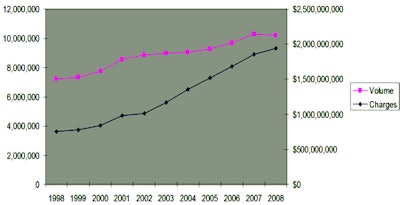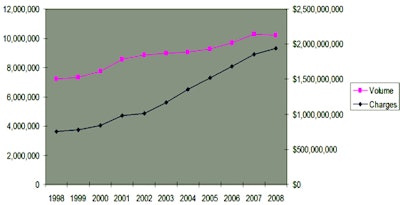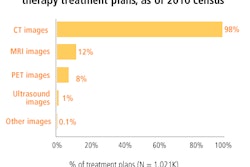
How much is the U.S. government paying for cancer treatment for its senior citizens? From a radiation oncology perspective, the answer is a lot more than it used to pay before sophisticated radiation therapy treatments such as intensity-modulated radiation therapy were developed.
Attendees at the recent RSNA annual meeting in Chicago learned that the cost of radiation therapy for Medicare patients had soared over a 10-year span, according to an analysis of radiation therapy utilization and associated costs conducted at Thomas Jefferson University (TJU) in Philadelphia.
Researchers from the Center for Research on Utilization of Imaging Services reported that between 1998 and 2008, the cost of radiation therapy increased by 156%, while the number of patients receiving the treatments increased only by 33%.
Medicare-allowed charges for radiation therapy increased from $759 million in 1998 to $1.94 billion in 2008. By comparison, the number of treatments per year rose at a modest rate, from 2,690,233 procedures in 1998 to 3,573,902 procedures in 2008.
Because little research about the utilization and cost of radiation therapy for the Medicare population has been conducted, the TJU team decided to investigate, explained presenter Laurence Parker, PhD, director of health services and outcomes research. The group's findings confirmed increasing utilization of sophisticated radiation therapy treatments in the U.S.
The researchers used data from the nationwide Medicare Part B Physician/Supplier Procedure Summary Master Files for 1998 through 2008. They extracted records for 76 radiation oncology procedure codes, grouping them by major headings in the CPT-4 procedure manual. Then they calculated the number of procedures performed in each category, as well as the cost in allowed charges. The team also evaluated claims by physician specialty.
Only professional and global charges were counted, Parker said; technical claims were excluded because they would have led to double counting. Allowed charges included all professional and global charges, and all technical charges billed by private practices. Because technical outpatient and inpatient charges were not included, the actual costs reported in the survey are even higher.
 |
| Overall radiation oncology volume and charges. Image courtesy of Laurence Parker, PhD. |
"Most of the growth in charges seems to be due to the use of intensity-modulated radiation therapy [IMRT]," Parker explained. "The volume of IMRT procedures increased 930% since 2002, when the procedure code was first introduced. In 2002, only 115,252 procedures were performed, compared to 1,188,907 procedures in 2008."
Prostate cancer patients receive the largest number of IMRT procedures, said P. Rani Anne, MD, a co-author of the paper and clinical director of TJU's department of radiation oncology, in a subsequent interview with AuntMinnie.com. The American Cancer Society estimated that in 2010 approximately 218,000 patients would be diagnosed with prostate cancer, two-thirds being men older than 65. So as the baby boomer, post-World War II generation becomes eligible for Medicare, the researchers expect an escalation in the volume of procedures.
"Image-guided radiation therapy [IGRT] is showing a similar growth in utilization," Parker said. "Between 2006, when 274,241 procedures were performed, and 2008, when 753,912 procedures were performed, there has been an increase of 175%."
Radiation oncology and radiology departments performed most radiation oncology procedures (93%) in 2008. Eleven percent of all procedures were performed by other medical specialists, such as surgeons. Parker noted that with the entry of the baby boomers into Medicare coverage, the costs versus benefits of radiation oncology treatments should be carefully evaluated.
One trend that Anne and Parker expect to see expand is the use of hypofractionated treatment, they told AuntMinnie.com. Hypofractionated treatment can reduce both the number of treatments and the overall cost. Healthcare facilities in Canada, the U.K., and many European countries have pioneered this treatment, which, anecdotally, seems to be increasing in the U.S.
"Undoubtedly we will analyze this in the future," Parker said. "The value of the studies that we conduct is that you can see what is happening nationally with a portion of our population where data are available. You can see the magnitude of dollars involved when expensive technologies are adopted, and when ways to reduce their costs -- such as hypofractionated treatment -- are available."
"Costs have been rising astronomically for cancer treatment, and radiation oncology is one source," Anne commented, noting that chemotherapy costs have also skyrocketed.
However, putting procedure volumes and costs into a larger perspective, radiation therapy treatment volume is only about 7% of diagnostic imaging volume for Medicare recipients, and radiation oncology charges are only about 19% of diagnostic imaging charges.
By Cynthia E. Keen
AuntMinnie.com staff writer
January 10, 2011
Related Reading
Cancer cost world economy $895B in 2008, September 3, 2010
U.S. cancer expenses double over 20 years, May 10, 2010
Medicare cancer imaging grows at twice rate of overall expenses, April 27, 2010
Copyright © 2011 AuntMinnie.com



















